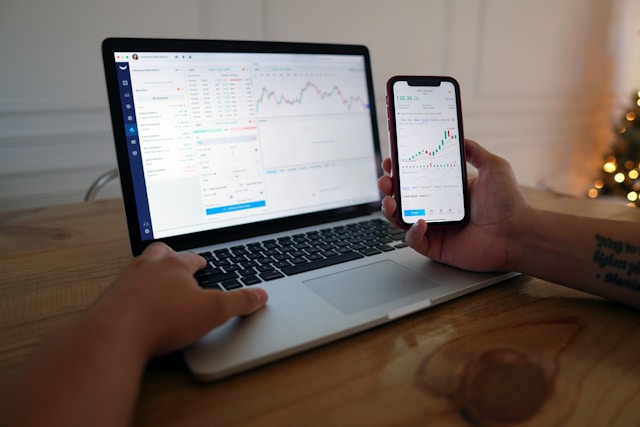The allure of day trading beckons with promises of freedom, flexibility, and the potential for significant wealth. Images of fast-paced trading floors and shrewd individuals making fortunes in a single day fill the popular imagination. But is day trading a real job? The answer, like the financial markets themselves, is complex.
What is Day Trading?
Day trading involves buying and selling financial instruments like stocks, options, or currencies within the same trading day. Unlike long-term investors who hold positions for months or years, day traders capitalize on short-term price movements. Their goal is to exploit market inefficiencies and profit from small price fluctuations throughout the day.
This fast-paced style of trading requires constant monitoring of market movements, news, and economic data. Day traders rely on a combination of technical analysis, which involves studying charts and historical price patterns, and fundamental analysis, which focuses on a company’s financial health and industry trends.
The Realities of Day Trading
While the potential rewards of day trading can be significant, the risks are equally substantial. Here’s a deep dive into the realities of this demanding profession:
- High Failure Rate: Studies suggest that a significant percentage of day traders lose money. The fast-paced, high-pressure environment can lead to emotional decision-making and impulsive trades. Without proper discipline, risk management strategies, and a solid understanding of the markets, success in day trading is elusive.
- Significant Time Commitment: Day trading is not a get-rich-quick scheme. It requires a substantial time investment. Successful day traders dedicate long hours glued to their screens, meticulously analyzing charts, researching companies, and actively managing their positions.
- Financial Requirements: Day trading can be capital-intensive. While some platforms allow trading with smaller accounts, achieving consistent profitability often necessitates a larger starting capital. This buffer allows for absorbing losses and taking advantage of trading opportunities.
- Emotional Control: The emotional rollercoaster of the markets can be overwhelming for the uninitiated. Day traders must develop discipline and resist the urge to panic-sell during downturns or chase after every upward blip. Maintaining a cool head and sticking to a well-defined trading strategy are paramount.
The Skills of a Day Trader
Beyond the financial resources and time commitment, successful day traders possess a unique skillset:
- Analytical Acumen: The ability to analyze market data, interpret charts, and identify potential trading opportunities is crucial. Day traders must be adept at recognizing technical patterns and understanding how economic data and news releases impact markets.
- Risk Management: Effective risk management is the cornerstone of a successful day trading strategy. Setting stop-loss orders to limit potential losses and taking profits when targets are reached are essential practices. Day traders must also be comfortable with the inherent volatility of the financial markets.
- Discipline and Self-Control: The emotional fortitude to stick to a trading plan, avoid impulsive decisions, and learn from mistakes is vital. Day trading requires discipline and the ability to remain objective under pressure.
- Technological Savvy: Day traders leverage a wide range of trading tools and platforms. Understanding charting software, news feeds, and market analysis tools is essential for making informed decisions.
Is Day Trading Right for You?
Before embarking on a day trading career, it’s crucial to assess your financial situation, risk tolerance, and personality. Here are some key considerations:
- Financial Stability: Day trading should not be seen as a way to get out of debt or solve immediate financial problems. It’s recommended to have a stable financial foundation and a separate source of income before putting your capital at risk.
- Risk Tolerance: Day trading inherently involves a high degree of risk. Individuals with a low tolerance for risk or those who are easily rattled by market fluctuations may not be best suited for this profession.
- Discipline and Patience: Successful day trading requires unwavering discipline and the patience to see your strategy through. Building a successful track record takes time, dedication, and the ability to learn from losses.
Launching Your Day Trading Career: A Step-by-Step Guide
The world of day trading beckons, and you’re determined to carve your path. This section serves as a roadmap to navigate the initial stages of your day trading journey.
Step 1: Knowledge is Power – Education and Skill Development
- Foundational Education: Immerse yourself in the fundamentals of financial markets, technical and fundamental analysis, and trading psychology. Numerous online courses, workshops, and textbooks can equip you with the essential knowledge. Reputable sources like Investopedia, Khan Academy, or Coursera offer valuable educational resources.
- Technical Proficiency: Master the trading platform you choose. Familiarize yourself with its features, charting tools, order types, and risk management functionalities. Explore tutorials and training materials offered by the platform provider.
- Practice Makes Perfect: Utilize demo accounts and paper trading platforms extensively. Experiment with different strategies, hone your technical analysis skills, and develop a feel for market movements in a risk-free environment.
Step 2: Craft Your Strategy – A Roadmap to Success
- Define Your Goals: Outline your trading goals. Are you aiming for short-term income generation or building long-term wealth? Setting clear objectives helps tailor your strategy.
- Risk Management is Paramount: Develop a risk management framework. This includes setting stop-loss orders to limit potential losses, defining position sizing (the amount of capital allocated per trade), and utilizing take-profit orders to secure gains when targets are reached.
- Choose Your Weapons: Select a trading strategy that aligns with your personality and risk tolerance. Popular day trading strategies include scalping (exploiting minor price fluctuations), swing trading (holding positions for a few days), and momentum trading (capitalizing on short-term price trends). Research and backtest different strategies to find the one that suits your trading style.
Step 3: Assemble Your Arsenal – Tools and Resources
- Trading Platform: Select a reliable trading platform that offers the features and functionality you need. Consider factors like order execution speed, real-time market data feeds, charting tools, and commission costs. Popular options include TD Ameritrade, Interactive Brokers, and E*Trade.
- Market Data Feeds: Subscribe to real-time market data feeds to stay on top of breaking news, quotes, and analysis that can influence your trading decisions. Consider services like Reuters, Bloomberg, or specialized market data providers tailored for day trading.
- Technical Analysis Tools: Invest in advanced charting software to conduct in-depth technical analysis. These tools offer a variety of technical indicators, drawing tools, and historical data analysis capabilities. Popular options include TradingView, MetaTrader, and NinjaTrader.
- Financial News and Analysis: Stay informed about market trends, economic data releases, and company news by following reputable financial news sources like The Wall Street Journal, Financial Times, or Bloomberg. Additionally, follow market analysts and commentators whose insights align with your trading strategy.
Step 4: Cultivate the Right Mindset – Discipline and Continuous Learning
- Emotional Control: The emotional rollercoaster of the markets can be intense. Develop the discipline to stick to your trading plan, avoid impulsive decisions, and learn from mistakes.
- Continuous Learning: The financial markets are dynamic. Stay current with new trends, economic developments, and technological advancements that might impact your trading strategy. Regularly review and refine your approach to ensure it remains effective.
- Seek Mentorship: Consider seeking guidance from experienced day traders. Mentorship can provide invaluable insights, help identify blind spots in your strategy, and offer support during challenging times.
Step 5: Start Small and Scale Gradually
- Begin with a Modest Account: Don’t risk your entire savings. Start with a manageable account size that allows you to gain experience and refine your approach without incurring significant losses.
- Focus on Consistency: Focus on developing consistent, profitable trading habits rather than chasing large, infrequent wins. Building a successful track record takes time and discipline.
- Track Your Performance: Maintain detailed records of your trades. Regularly analyze your performance to identify areas for improvement and track your progress towards your trading goals.
By following these steps and approaching day trading with dedication, discipline, and a commitment to continuous learning, you can increase your chances of success in this challenging but potentially rewarding field. Remember, day trading is not a get-rich-quick scheme. It requires hard work, perseverance, and the ability to manage risk effectively.
Building Your Day Trading Arsenal: Tools and Resources
Once you’ve familiarized yourself with the fundamentals and developed a trading strategy, it’s time to assemble your day trading toolkit. Here are some essential resources:
- Trading Platforms: Choose a reliable trading platform that offers the features and functionality you need. Consider factors like charting tools, order execution speed, real-time market data feeds, and commission costs. Popular options include TD Ameritrade, Interactive Brokers, and E*Trade.
- Market Data Feeds: Real-time market data is the lifeblood of any day trader. These feeds provide up-to-the-minute quotes, news, and analysis to help you make informed trading decisions. Consider services like Reuters, Bloomberg, or specialized market data providers tailored to day trading.
- Technical Analysis Tools: Advanced charting software allows for in-depth technical analysis. These tools offer a variety of technical indicators, drawing tools, and historical data analysis capabilities. Popular options include TradingView, MetaTrader, and NinjaTrader.
- Financial News and Analysis: Stay abreast of breaking news and market analysis from reputable financial sources. Subscribe to financial news outlets like The Wall Street Journal, Financial Times, or Bloomberg. Additionally, follow market analysts and commentators whose insights align with your trading strategy.
- Trading Communities: Connect with other day traders through online forums, chat rooms, or social media groups. Engaging with a community can provide valuable insights, share experiences, and offer support during challenging market conditions.
Practice Makes Perfect: Demo Accounts and Paper Trading
Before risking real capital, hone your skills and test your strategies using demo accounts and paper trading platforms. Many online brokers offer demo accounts that allow you to simulate real-world trading with virtual funds. This provides a safe environment to experiment with different strategies, get comfortable with the trading platform, and develop a feel for the markets.
Paper trading takes it a step further. Paper trading platforms mimic real-world market conditions but use fictitious funds to track your performance. This allows you to test your trading strategy in a realistic setting without risking real money.
By diligently practicing with demo and paper trading accounts, you can identify weaknesses in your strategy, refine your approach, and build confidence before venturing into the live markets.
The Ongoing Grind: Discipline, Continuous Learning, and Adaptability
The path to becoming a successful day trader is a marathon, not a sprint. Here are some essential habits to cultivate for long-term success:
- Maintain Discipline: Adherence to your trading plan is paramount. Stick to your entry and exit points, manage risk effectively, and avoid letting emotions cloud your judgment.
- Continuous Learning: The financial markets are constantly evolving. Stay up-to-date on new trends, economic developments, and technological advancements that might impact your trading strategy. Regularly review and refine your approach to ensure it remains effective.
- Adaptability: Markets are inherently volatile. Be prepared to adapt your strategy as market conditions change. Remain flexible and willing to adjust your approach based on new information and evolving market dynamics.
- Track Your Performance: Maintain detailed records of your trades. Regularly analyze your performance to identify areas for improvement and track your progress towards your trading goals.
- Seek Mentorship: Consider seeking guidance from experienced day traders. Mentorship can provide invaluable insights, help identify blind spots in your strategy, and offer support during challenging times.
Alternative Paths: Exploring Other Trading Avenues
While day trading offers a particular brand of excitement and fast-paced action, it’s not the only way to participate in the financial markets. Here are some alternative paths to consider:
- Swing Trading: Swing trading involves holding positions for a longer timeframe than day trading, typically days to weeks. This approach allows for capturing larger price movements while requiring less time commitment compared to day trading. Swing traders often utilize technical analysis to identify swing trading opportunities.
- Positional Trading: Positional trading focuses on long-term trends, holding positions for weeks, months, or even years. This style of trading relies heavily on fundamental analysis, focusing on a company’s long-term prospects and industry trends. Positional traders prioritize in-depth research and patience over active trading.
- Algorithmic Trading: Algorithmic trading, also known as automated trading, utilizes computer programs to execute trades based on pre-defined rules and technical indicators. This approach removes emotions from the equation and allows for faster reaction times to market movements. However, developing and maintaining effective trading algorithms requires significant programming expertise.
- Copy Trading: Copy trading allows investors to automatically copy the trades of experienced traders. This approach can be beneficial for beginners who are still learning the ropes, but it’s crucial to choose reputable traders with a proven track record. Remember, past performance is not necessarily indicative of future results.
- Investing in ETFs and Mutual Funds: For those who prefer a less hands-on approach, investing in diversified exchange-traded funds (ETFs) and mutual funds can be a viable option. These investment vehicles offer exposure to a basket of stocks or other assets, providing built-in diversification and professional management.
The Importance of Diversification
Regardless of the trading style you choose, diversification is paramount. Spreading your capital across different asset classes, such as stocks, bonds, commodities, and real estate, helps mitigate risk and smooth out market fluctuations.
Conclusion: Day Trading – A Challenging but Potentially Rewarding Path
Day trading presents a unique opportunity for those who possess the necessary skills, discipline, and risk tolerance. However, it’s a demanding career path that requires significant dedication and continuous learning. Carefully evaluate your risk tolerance, financial situation, and personality before embarking on this journey.
For those who prefer a less time-intensive approach, alternative trading styles and investment vehicles offer other ways to participate in the financial markets. Remember, successful investing is a marathon, not a sprint. Develop a sound strategy, prioritize risk management, and maintain a long-term perspective for navigating the ever-evolving world of finance.






